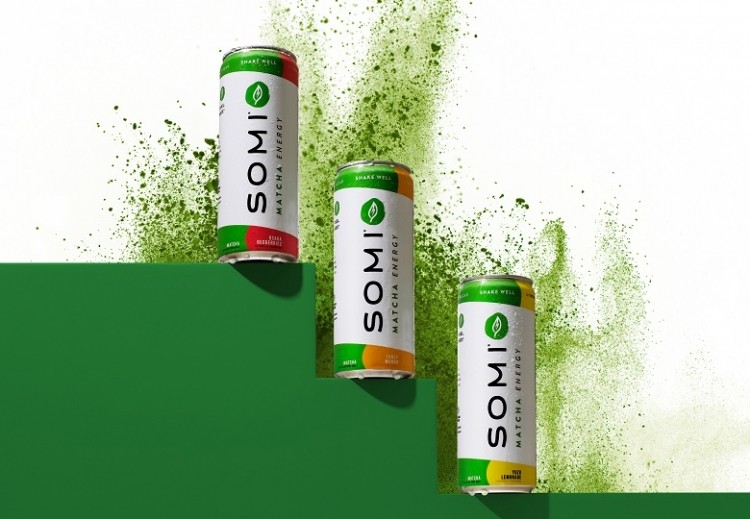SOMI relaunches energy drink line with new formulations, flavors

Billed as a 'natural energy drink' with 140mg caffeine from green tea extract and matcha, SOMI contains 10-15 calories per 12oz can and is sweetened with monk fruit and stevia.
Since the start of 2023, the Austin-based energy drink start-up has made several updates to its beverage line, as Arianna Salinas, cofounder and CEO of SOMI, shared with FoodNavigator-USA, all to improve the end product for consumers.
Salinas spent the first half of 2022 partnering with local retailers, sampling products, and getting a sense of what consumers think about the product. Then, with that information in hand, SOMI could spend the second half of the year reformulating and repacking, she said, leading to several changes in the new year.
SOMI opts for a sleeker, slimmer can
On the packaging front, SOMI decided to move from a 16 oz. to a 12oz 'sleek' can, which is more in line with current energy drink brands such as ZOA, C4, and Monster, Salinas said. But not only was the decision based on what SOMI’s competitors are doing, but the brand had several practical reasons for making the switch.
For one, with the larger can format, SOMI consumers would say “I'm not finishing it, or it's not cold enough by the time I'm done with it,” Salinas said. However, she also noted another practical reason for the move to a smaller can size.
"[The] big thing with matcha is that it naturally settles, so you have to consume it quickly once you open it otherwise all the matcha is going to sit at the bottom of the can... And you're wasting the best part of the product."
Reformulating to a non-carbonated energy drink
In terms of the reformulation, the biggest change was that SOMI moved from being a carbonated to a non-carbonated beverage, Salinas said. For one, "matcha is not water soluble, so you actually want to shake the product, and the only alternative to that was to add a gum. For us, that kind of defeats the entire purpose of our product," she added.
But as often is the case, reformulations come with some form of trade-off, Salinas pointed out. "We found with everything in the market you had to sacrifice something. If it's not sugar, it's sucralose. If it's not sucralose, it's a gum… and we really wanted to keep that clean label without any sacrifice in the ingredients.” So, ultimately, SOMI went with a non-carbonated version to replace its original, carbonated version.
Three new flavors inspired by Japanese heritage
A new can size and switching to a non-carbonated version weren't the only part of the brand’s relaunch, as it also released three new flavors — Yuzu Lemonade Matcha, Fancy Mango Matcha, and Osaka Redberries Matcha.
For these beverages, they pay homage to the origin of SOMI’s hero ingredient matcha, which the company sources from Japan. For Yuzu lemonade, SOMI took a “familiar lemon flavor” with an “Asian flair” and blended it with the nostalgic taste of lemonade, Salinas said. For the Fancy Mango beverage, SOMI was trying to tell a story about a very specific Japanese mango, Salinas explained.
"In Japan, there's a particular type of mango, [that] they treat ... like jewelry. You go into the store, [and] you buy them from a jewelry case —like they are a prized possession," she added. So, in Fancy Mango, SOMI was trying to "point at that story and also tie in a traditional flavor."
For Osaka Redberries Matcha, SOMI wanted to "stick to the red fruits," as most of berry-flavored beverages come out turning blue, Salinas said. Citing another Japanese tradition, she noted that Japan has a tradition of strawberry picking. This was another way that SOMI was able to pay homage to Japan while also providing a familiar taste.
The decision to use a combination of stevia and monk fruit as sweeteners was because “monk fruit on its own can have an aftertaste; stevia on its own can have an aftertaste," but by using the two, they “balanced each other out nicely to where you didn’t notice an aftertaste,” she explained.
Growing at a sustainable pace
While many beverage start-ups feel the need to get their product into as many stores across the US as quickly as possible, Salinas described a more localized, slow-and-steady approach to SOMI’s market strategy. Currently, SOMI’s primary focus is Texas, and more specifically, Austin, Texas, (though the product can be purchased on Amazon as well).
“You see it often when brands come in, and they expand very quickly, and then they implode because you can't keep up,” Salinas said. “It's one thing to get on the shelf; it's another thing to get your product off the shelf and into the hand of the consumer.”
In addition to the announcement of new beverage flavors and can sizes, SOMI also started the year with one more partner – Texas-based grocery store chain Central Market, which Salinas described as the "ideal partner” with its focus on natural products.
While the east and west coasts tend to get most of the food and beverage start-up attention, Salinas noted that Austin has become a hub for food and beverage innovation, with seasoned food and beverage veterans operating in the space, including Clayton Christopher, the founder of Sweet Leaf Tea and Deep Eddy Vodka.
"Silicon Valley is for tech ... what Austin is for CPG," she added, noting that Southern hospitality is here to innovate the food and beverage industry.







